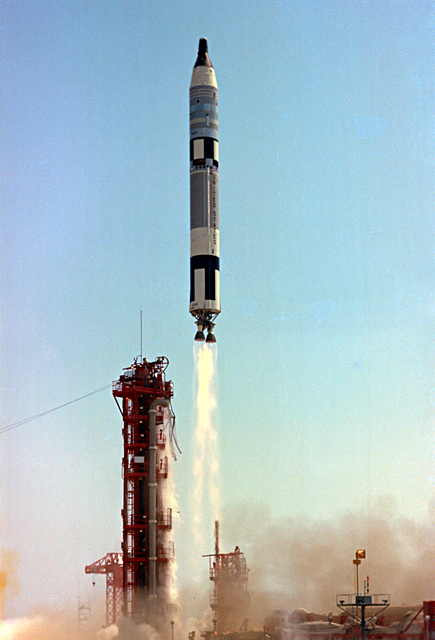This beautiful display has some serious science behind it. You all know that as the orbiter ascends, it is traveling through increasingly rarefied atmosphere, until it reaches a near vacuum at orbital altitude. You also know that the Space Shuttle Main Engines (SSME) works off of Newton's First Law of Motion, and the action of the exhaust leaving the engine bell produces the reaction of the engine and shuttle moving away. The exhaust does not need to 'push' against anything to produce thrust. While this is true, the exhaust does push against something, the gasses of atmosphere. At sea level, atmospheric pressure helps constrain the exhaust into the familiar plume we see.
This Gemini-Titan launch shows an exhaust plume
constrained by sea level atmospheric pressure.
(Image by NASA)
As the rocket ascends, the thinner atmosphere allows the exhaust plume to expand. Engineers plan for this with the shape of the engine exhaust bell. Second-stage engine bells designed to work at high altitude are different than those on the first stage booster. Some engines are designed with an extendable collar that slips down at high altitude to take advantage of the expanding exhaust by increasing the length of the bell.
Notice different exhaust plume indications in this simplified SSME illustration.
(Image by Pratt and Whitney)
The SSMEs are designed to operate through the whole atmosphere, and optimized for mid altitudes after solid rocket booster seperation. When the orbiter reaches higher altitudes the exhaust rapidly expands. Although this lowers the efficiency of the SSME, the decreasing weight of the external tank and lack of atmospheric drag allow it to continue to thrust the shuttle to orbit. The video above (which appears to have been taken from near the US 1 highway in Titusville, FL) shows this expanding plume. Remember, this happens on every flight. What made this different was the darkness of the sky and the plume being illuminated by the sun just over the horizon. A beautiful confluence of technology and nature.
Aftermath of the launch plume in the light of sunrise.
(Picture by Jim Gerard)






No comments:
Post a Comment